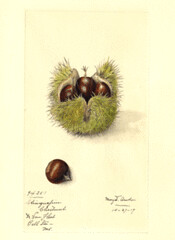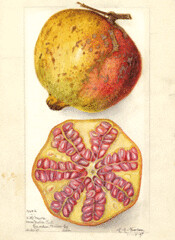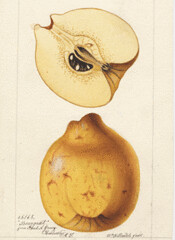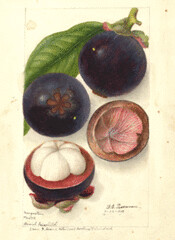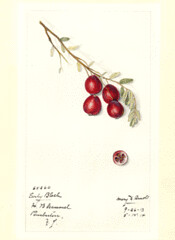I came across this article while Googling for information on date palm sex inheritance the other night:
A primitive Y chromosome in papaya marks incipient sex chromosome evolution (Nature)
Unless you're a Nature subscriber, however, you can only read the abstract there, so try this for a more complete overview:
Scientists discover that papayas have sex chromosomes (University of Georgia)
It's an older article, but not one I'd seen. However it was not on date palm, so it was not immediately and directly relevant and I thought I'd wait until Friday to make it the launching point for another installment in this series.
The inheritance of sex in humans is probably one of the very first traits students learn the genetics behind (along with a vastly over-simplified and essentially incorrect description of the
inheritance of eye color). It's a simple system, with a pretty distinct, binary (for the most part) phenotype, and it's something everyone cares about. Of course, sex isn't unique to humans. Plants and animals have distinct sexes as well--though sometimes they aren't quite so distinct. In fact, a majority of plants (and most fruit crops) are hermaphrodites (ie, they are simultaneously male and female), and there is evidence that suggests this is the ancestral state of plants as a whole--sex is a later invention.
Inheritance of sex in plants varies from species to species, and in fact may have evolved independently over a hundred times. It turns out, however, that an amazing lot of species have developed a similar system to people: females are homozygous (XX), and males are heterozygous (XY). Just like in humans, this will generally work out to a 1:1 ratio of male:female in the offspring. However, since sex is a little more flexible in many plants, some male plants will set the occasional fruit (interestingly, it virtually never happens the other way around, with male flowers on females). These self-pollinations show a 3:1 of males to females (or, occasionally 2:1, if the YY plants aren't viable). So we know that male is the heterozygous sex. Because of this, a locus denoted
SuF, for supressor of femaleness, was theorized. However, as the trait was further studied, it became clear, in part through cytological studies of chromosome deletion, that there were multiple loci involved, at least one or two more, involved in anther development. Hermaphrodites can result from mutation in one or the other of these genes.
In virtually all species, these genes are closely linked together. This makes sense, when you think about it: having "maleness" conditioned by multiple genes only works if you don't occasionally lose them to recombination. If a species is going to evolve separate sexes, and maintain them, these genes need to consistently work together to produce functional males. In some species these genes are an autosome (one of the standard, non-sex chromosomes) just like any other gene. However, despite the tight linkage, autosomes undergo crossing-over and recombination, so there will always been some risk of the linkage being broken up.
Enter the sex chromosome. Not all species that have sexes have sex chromosomes, getting by just fine keeping the required genes on an autosome. However, a sex chromosome has a major advantage, and that is to prevent recombination in the critical bit of genome. The human X and Y chromosomes may pair cytologically, but they're not two slightly different copies of the same thing the way the maternal and paternal copies of most chromosomes would be--there's vast differences in the content of the two (there would have to be given the size difference). I presume that's why the trait is denoted XX/XY not Xx/xx or
SuF/
Suf in people--we're really talking whole chromosomes assorting here, not just a trait.
(Note that although the XX/XY scheme is pretty common, it's by no means the only one out there. Birds have a ZW/ZZ scheme (just the same, but females are the heterozygous sex), and in some species there is no Y...just one or two copies of the X. The monotremes (such as the playtpus or the echidna) have one of the most bizarre schemes of all with multiple versions of both X and Y--for example in the short-beaked echidna it's XYXYXYXYX for males and XXXXXXXXXX (yes, there is one unpaired X in the male). I'm going to deal with XX/XY scheme exclusively for now, for fear of making things even less intelligible than they are now.)
Having two distinct sex chromosomes is useful in that by having two very different chromosomes, you suppress recombination, thus keeping things together appropriately. However, the trick is to have two different chromosomes that nonetheless pair up during meiosis, so that you always get one of each in each gamete. This can be accomplished because a portion of each sex chromosome remains similar (and thus capable of recombination). In people, a small area at one end of the X and Y chromosomes is identical and functions essentially as an autosome. Because this area does have a mate to seek out at meiosis, it pulls the non-pairing, non-recombinant bits along with it.
So how is recombination suppressed in the rest of it? The specifics aren't entirely clear, but basically the end result is that the Y chromosome ends up highly degenerate, accumulating deletions and mutations until, in some cases like humans, only a tiny handful of functional genes remain on it. That's probably why in many cases YY individuals aren't viable at all--they're missing functional copies of critical genes.
Plant Y chromosomes, it turns out, are on the whole not nearly as far gone as their mammalian counterparts. That's part of why people got excited about the papaya sex chromosomes. In papaya, normal recombination still occurs over 90% of the chromosome (compare that to less than 10% in humans), with only a small portion, which contains the male-determining genes, with evidence of heavy mutations and translocations. Because of this, it appears to be a sex chromosome in a very early stage of development, and provides a clear piece of evidence for the idea that sex chromosomes developed from autosomes. Recent
work by geneticists shows that the non-recombinant region of the Y chromosome has a comparative lack of functional genes, and they estimate that the sex chromosomes evolved 1.3 to 2.8 million years ago, a mere twinkling of an eye in evolutionary terms.
Sex chromosomes appear to be more the exception than the rule in cultivated plants, however. One very good reason for this is probably the fact that most crop plants are hermaphrodites, and thus unlikely to be species with highly developed sex determination mechanisms. Some species (such as grapes) exist as males and females in the wild, but largely only as hermaphrodites in cultivated plants (the grape sex locus appears to be on an autosome). As far as I know, there are only two fruit crops that possess sex chromosomes: papaya (
Carica papaya) and kiwi (
Actinidia species). However, given how much more subtle the difference in previously described plant sex chromosomes are, there might well be some we have not yet discovered in fruits.
Papaya throws another wrinkle into the story by having hermaphrodites as well as male and female plants. Papaya cultivars, which are seed propagated, fall into two categories: those whose seeds give rise to male and female plants, and those that give rise to female and hermaphrodite plants (a majority of commercial cultivars are of that type, which makes sense, because who would want the non-fruitful male plants around). It appears that there may be two "flavors" of Y chromosome, one with a functional
SuF-type gene, and one without (but still possessing the necessary genes for anther development). This is supported perhaps by the fact it does not seem possible to generate a true breeding hermaphrodite papaya, perhaps because YY plants are not viable. In other words:
XfXf = female
XfYM = male
XfYH = hermaphrodite
YMYM = not viable
YMYH = not viable
YHYH = not viable
Now that I've prattled on for a zillion words or so, I'd like to end on a brief note of caution...I'm not a papaya geneticist, so I may have gone horribly wrong in some of this, but this is the situation as I understand it.
The same goes for my understanding of kiwi, but I think it's interesting to note that although many kiwi species are polyploid, sex determination remains determined by a single gene pair, despite the sex chromosomes being duplicated (contrary to some early papers which suggested they were not, so that 2n=58=2x+XY but 2n=170=6x+XY...turns out that it's just really hard to count that many chromosomes...the hexaploids really had 174). So it looks as though there's a single pair of sex chromosomes that retains the ability to determine sex. (This also appears to be the case in octoploid strawberry, although the sex genes are on an autosome(s)).
Anyway, there it is. Probably the least exciting discussion of sex you've come across. (This will have to do for the time being instead of the persimmon sex post I mentioned in the comments a few days ago...I'm not sure of what became of it...I wrote it in Word because I was offline and on a plane at the time, and now I'm not sure where it is. Might be on the work laptop...(Sorry, Brandon.))
Labels: actinidia, carica, Fruit Genetics Friday, genetics, kiwi, papaya



